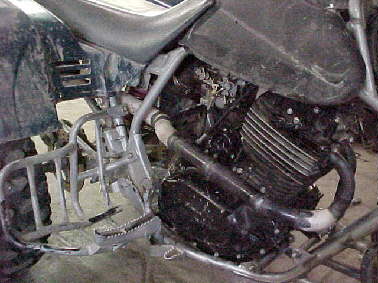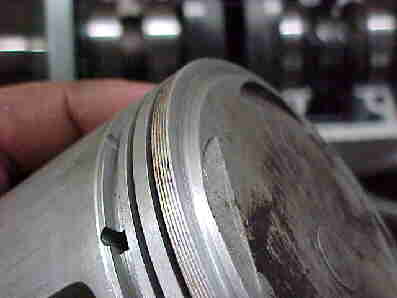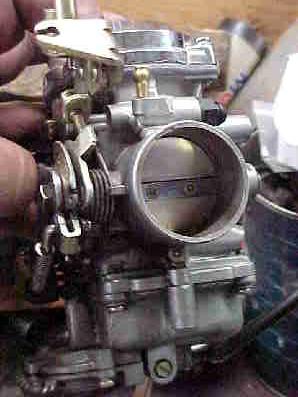

 The mating of a Kawasaki Lakota and a Honda Ascot. The Lakota engine let go. The step
son was wanting more power anyway. So the FT500 engine is finding its way into the Lakota
frame. The FT500 is basically the same as the XR,XL 500-600 dirt bike engines except it has electric start. Wow this thing hauls!
The mating of a Kawasaki Lakota and a Honda Ascot. The Lakota engine let go. The step
son was wanting more power anyway. So the FT500 engine is finding its way into the Lakota
frame. The FT500 is basically the same as the XR,XL 500-600 dirt bike engines except it has electric start. Wow this thing hauls!
These FT500 engines get a lot of bad press for having wimpy electric starters. I took a look inside the solenoid, pivot fork, latch housing and saw corrosion keeping the parts from working. So I drilled a small hole near the top to vent the moisture back into the crank case, and another hole low to drain any oil back into the crankcase. Sure seems to be the answer.....
Something has gone away in the charging system, and the battery is always dead.

 Using the stock carburetor required a spacer, which also angled the carb away from the air
filter housing, to make clearance for the fuel inlet hose. You can also see the 2" exhaust pipe
I used to get from the carb inlet to the stock air box.
Using the stock carburetor required a spacer, which also angled the carb away from the air
filter housing, to make clearance for the fuel inlet hose. You can also see the 2" exhaust pipe
I used to get from the carb inlet to the stock air box.
We even used the stock snorkel. You'll notice the dent towards the front of the snorkel, its from
the same wreck that damaged the front fenders. I will try to plastic weld them?????

 Left, the start of the home made Supertrapp.
Left, the start of the home made Supertrapp.Right, the business end of the muffler.
600 | ||||||||||
 This hat moves the sprocket inboard .75" to align with the narrower engine. The rear sprocket is from a YZ490. I am not satisfied with this gearing yet.
This hat moves the sprocket inboard .75" to align with the narrower engine. The rear sprocket is from a YZ490. I am not satisfied with this gearing yet.
The gearing (15/42) is a bit to high for woods riding. The top end never seems to quit
The Honda 400EX has 15/38, maybe it has different primary gearing? Finally have settled
on 14/44, top speed seems to be around 75-80, 1st is ok for trail riding, and it
wheelies
easily.

 I just recieved an '86 XL 600 engine, purchased on eBay. It should have the 100mm bore, coupled to the FT500s 80mm stroke it will displace 628cc.
I just recieved an '86 XL 600 engine, purchased on eBay. It should have the 100mm bore, coupled to the FT500s 80mm stroke it will displace 628cc.
The XL 600 has hi perf valve gear, the cam is marked 148X9 but has a bad lobe. The exhaust will also receive a larger diameter head pipe, and retapered back section. The best thing will be the switch to dry sump oiling. Fins and air ducting on the tank will help cool the oil.
Right, XL piston with a notch cut around the
the top. This allows me to use it with the longer stroke crank from the FT 500, and not bump into the head. It also raise the compression ratio. To use this piston I will need to put the XL rod on the FT crank. The wrist pins are not the same size. There are pistons available to big bore the FT to 100mm though.
13 July 2011, a JE Piston #128995 has been ordered. A HotRods connecting rod is also coming, as is a 13 tooth countershaft sprocket. I will need to send the cam and rocker back to MegaCycle and have it repaired. Then I will have to start looking for jetting to get that HD carb working on the XL600.
 Left, Thinking about 40mm CVKs from a Harley Davidson. The first HD carb arrives. Still thinking about a daul carb set up.
Left, Thinking about 40mm CVKs from a Harley Davidson. The first HD carb arrives. Still thinking about a daul carb set up.These early XL engines had dual carbs, one acted as a primary, the other a secondary. I plan to use two carbs. With one twist however. I will run the FT500 34mm carb as a primary, and a Harley 40mm CVK as the secondary. That should work similar to a quadrajet or thermoquad from 1970s GM and Chrysler cars.
Since both Keihin carbs are Constant Velocity they will only open to the amount the engine is actauly able to pull in (Vacuum Secondaries). I do like the idea of accelerator pumps on 4 stroke engines. The HD carb is equiped with a accelerator pump while the FT is not. The accelerator should be on the primary carb. 2 40mm Harley carbs? The GM quadrajet has reservoir that pretty much just drops a quantity raw fuel into the secondary air column...The Yamaha Raptor uses a dual carb setup.
The primary exhaust is 1.125" diamater, just under 29mm. The carbs should be somewhat larger, especially in an Individual Runner system (no plenum). 2 40mm carbs seem like too much.
ONE THING IS CERTAIN, THERE IS NOT A REED VALVE ANY WHERE ON THIS INTAKE SYSTEM. So how do we go about squashing a 30 year old misunderstanding. The port is oval shaped, wider than it is tall. At some point farther into the head a center divider splits in into 2 round ports that feed the 2 intake valves. Back at the mounting face there is a rubber adapter that has 2 spigots for 2 carbs.
If you use a dual carb set up and set it up as primary and secondary you must have a common plenum chamber,so both valves can move fresh mixture into the cylinder. If one valve doesn't get fresh cool air until the secondaries open it will eventually overheat and fail (burned valve). Remember you spend more time on one carb (primary) than on both.
Again there is no reed valve intake, there isn't any room where one could fit into the intake tract. I will post pictures to demonstrate what I have found.
Ok, I need some internal gearing to slow this machine down. A 4-wheeler needs a smaller axle sprocket, for ground clearance. With the stock FT500 engine the gearing was way to tall. By the time I get the speed low enough for low gear trail riding the sprocket is constantly crashing into anything sticking up on the trail or road. So I like the XR650R gearing, but no one seems to know it the 650R parts will fit in the 600 cases. Now There is a big difference in the primary gearing. The transmission will be spinning a lot faster in the XR650R, this is good for torque capacity.
Lets suppose the engine makes 20 foot pounds of torque, at the crankshaft. If you multiply that 20 lbs by the gear ratio - 20 X 1.651, the XR650R transmission will feel 33.02 ft-lbs. The XR600 will see 20 X 2.188 or 43.76. Quite a bit of change in torque handling capacity by changing the primary ratio. If the XR600 transmission was designed to operate with 50 ft-lbs, and we swapped in the XR650R primary gears the same gear set should withstand 66 ft-lbs.
Now we need to consider the effect primary gearing has on % change (closing or widening the spread). lets assume a counter shaft speed of 1000RPM, and a main shaft speed of the same, and a 4:1 primary, this would give a crank RPM of 4000. Now lets shift down to 3rd. same 1000 RPM on the counter, but the main shaft jumps to 1250, so now the crankshaft is turning 5000RPM. So lets change to a 3:1 primary ratio. Same 1000 RPM on the counter shaft, and main shaft as the above examples. In direct the crank shaft will be spinning 3000 RPM, and shifting down to 3rd, the crank would see 3750 RPM. You can see the gear change produced a 1000 RPM split with 4:1, and a 750RPM split with the 3:1. This is a radical example, to demonstrate the point.